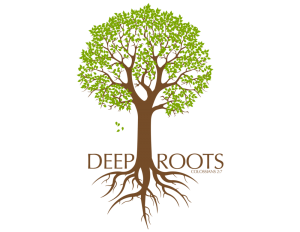John’s Gospel – An Introduction to the Book
How well do you know your “Bible Library”?
Of the 66 books in the Bible – which ones stand out to you? Which ones do you know best, or not at all? What would you say is the best one to grab if you need the book that tells you…![]()
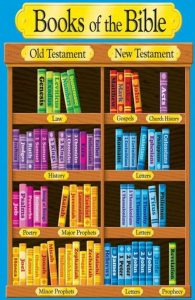
• The beginning of everything
• What happens with the end of everything
• Thoughts for your Quiet time or Devotions
• The doctrine of Salvation completely explained
• A new Christian’s first book to read
Yes, the last answer is the Gospel of John. Interestingly, it is both the deepest introduction of the Person of Jesus Christ, and the best place to start a new Christian reading the Bible and being introduced to Jesus Christ! It will be a privilege to study through this precious book of the Bible with you! We will be sitting at the feet of the Savior learning with the Apostles, and walking along with Him marveling as He ministers to the world around Him and then heads toward His final work with the Cross and Resurrection. Let us follow Him!
An important reminder: The Gospel of John is the best book of the Bible to guide a new Christian to (or one who has not been growing in Christ). And, you need to know the book first so that you can help this person understand what he reads!
![]() Bible Study Journal
Bible Study Journal
As you proceed through this study, you will find frequent reference to your using a Bible Study Journal to write down what you study and discover in God’s Word. Please don’t neglect this important habit! Get a spiral notebook, or use your computer. Either way, you will be rewarded with lasting learning and fresh recall! Click here to learn more about using a Bible Study Journal.
John’s Biography
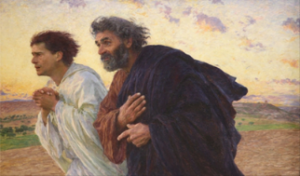
In Jn. 1:35-40, two of John the Baptist’s disciples make a decision to leave the Baptist and follow Jesus; Andrew is one, the other is likely John. Jesus’ “official” call to John and the others is a little later – see Matt 4:18-22, Mk 1:19.![]() John and his brother James are sons of Zebedee, a fisherman in Capernaum. Their mother is Salome (very possibly sister of Mary mother of Jesus , Jn.19:25, which would mean John & Jesus were cousins).
John and his brother James are sons of Zebedee, a fisherman in Capernaum. Their mother is Salome (very possibly sister of Mary mother of Jesus , Jn.19:25, which would mean John & Jesus were cousins).
John, his brother James & fellow fisherman Peter (Andrew’s brother) together became the “inner three” disciples. In Mk 3:17 – John & James were nicknamed “sons of thunder“ by Jesus; they were like rough & tumble guys, but John seems to be a “strong silent type”, he didn’t talk as much as Peter but he could hold his own. In Luke 9:54, where he suggests to Jesus “let’s torch the place“, referring to a village that rejected their testimony about Jesus. Note that this is the only time in the Synoptic Gospels that John is recorded speaking & acting on his own.
In Mk 10:35, John and James (along with Mom) ask Jesus to provide them a favored position in heaven; but note Luke 22:8ff, where John & Peter are the ones trusted by Jesus for the task of the Passover preparation, almost a prophetic passage, so no “favored position” was in the plan. Along with Paul, John & Peter are the most prominent leaders in Acts – Acts 1:13; 3:1ff; 4:1-22; 8:14-17; 12:1ff. And in Gal 2;9, Paul refers to John, Peter and James as a “pillars” of the Church.
“The one whom Jesus loved” is a unique phrase used by John to 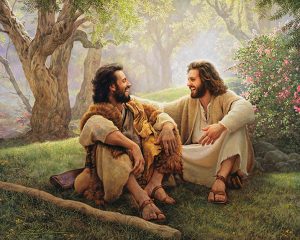 refer to himself (it is somewhat similar to the Bible referring to David as the “man after God’s heart”, 1 Sam. 13:14). John was very humble when recalling his experiences from time with the Savior, but he reveled in it (see 1 Jn. 1:1-3), possibly quietly chuckling when he wrote about it – how could any of us want anything better? Interesting that John doesn’t mention himself directly until Jn. 13:23, but then he also mentions himself at the Cross (Jn. 19:26-27), at the tomb (Jn. 20:2-9), and by the Sea of Galilee (Jn. 21:1,20-23) after their post-resurrection breakfast.
refer to himself (it is somewhat similar to the Bible referring to David as the “man after God’s heart”, 1 Sam. 13:14). John was very humble when recalling his experiences from time with the Savior, but he reveled in it (see 1 Jn. 1:1-3), possibly quietly chuckling when he wrote about it – how could any of us want anything better? Interesting that John doesn’t mention himself directly until Jn. 13:23, but then he also mentions himself at the Cross (Jn. 19:26-27), at the tomb (Jn. 20:2-9), and by the Sea of Galilee (Jn. 21:1,20-23) after their post-resurrection breakfast.
John 13:1 tells us that Jesus “loved them (the disciples) to the end”, that is, to the uttermost or to the full extent of His love. He loved them all the way to the last act, the outcome of His coming to live among us (Jn. 1:10-12; Jas. 5:11; 1 Pet 1:9). From the beginning of their journey together, He was ready to show them the full extent of His love as earthly companion and resurrected Savior.
Just to confirm, John really did write this Gospel – no really! This is in spite of some modern Bible critics that make efforts to question his authorship. Not only do the vast majority of early church sources confirm his authorship, but the distinctive “disciple whom Jesus loved” metaphor stands as a key evidence that this genuinely is John the brother of James writing. Other reasons not to question John’s authorship:
• He’s very much in the story as the Apostle John
• He alludes to himself only namelessly (Jn 13:23; 18:15-16; Jn. 19:26-27; 20:1-10; 21:7, 20-24) in order to maintain focus on the Lord
• In Jn. 21:24, it’s almost as if he’s saying “hey folks, I bow humbly before my Savior, but it’s really me writing”
• The other gospels (the Synoptics – Matthew, Mark and Luke) refer to John by name 20 times and these instances correlate to places in John where he refers to himself anonymously.
The Special Contributions of John
The Synoptic Gospels (“synoptic”, literally means “seeing together”) were written 55-60AD, earlier than John, much closer to Jesus’ time on earth. John wrote his Gospel 85-90AD, much later in his life – he likely assumes that his readers already have some knowledge about Jesus’ life. About 90% of John’s material is unique from the Synoptics. John provides much supplemental material that helps explain things mentioned more briefly in the Synoptics, or not mentioned at all. By comparison, John has none of the parables or the events casting out demons or healing lepers which are covered in the Synoptics.
- Examples of unique material only covered by John:
- Jesus’ Pre-existence & incarnation, Jn. 1:1-18
- Jesus’ early ministry in Judea & Samaria, Jn. 2-3
- Jesus’ first miracle, Jn. 2:1-11
- Conversation with Nicodemus, Jn. 3:1-21
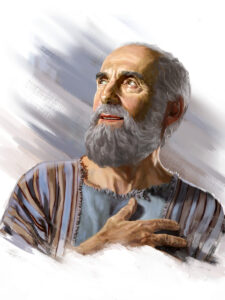
- The Samaritan woman at the well, Jn. 4:5-42
- Healing the lame man at the Pool of Bethesda, Jn. 5:1-15
- Healing the man born blind, Jn. 9:1-41
- The Bread of Life discourse, Jn. 6:22-71
- Jesus is Living water, Jn. 7:37-38 – also expressed in Jn. 4:14
- Jesus is I AM, Jn. 8:24
- The Good Shepherd, Jn. 10:1-39
- Raising of Lazarus, Jn. 11:1-46
- Washing the disciples’ feet, Jn. 13:1-15
- The Upper Room discourse, Jn 13-16
- Jesus’ High Priestly prayer, Jn.17
- Miraculous catch of fish, Jn. 21:15-29
- Overall more teaching on the Holy Spirit, Jn. 14, 16
- Taking another approach, here are examples of the rich doctrinal treasures found only in John:
- Jesus as the Creator, Jn. 1
- Jesus as the “only begotten” of the Father, Jn. 1
- Jesus as the promised “Lamb of God”, Jn. 1
- Deity of Christ – Jn 1
- God’s Sovereignty -Jn 6:44; 7:30; 10:27-30
- The Trinity, God acts as all three persons – Jn. 14:17, 20, 23
- The Eight Miracle “Signs” of John
- Water into wine – Jn. 2:1-11
 Heal official’s son – Jn. 4:46-54
Heal official’s son – Jn. 4:46-54- Healing at the Pool of Bethesda – Jn. 5:1-18
- Feeding the 5000 – Jn. 6:5-14
- Walk on water – Jn. 6:16-21
- Heal the blind man – Jn. 9:1-7
- Raise Lazarus – Jn. 11:1-45
- The Second Great Fish Catch – Jn. 21:4-8
- Jesus’ Seven “I AM” Statements in John:
- The bread of life – Jn. 6:35
- Light of the world – Jn. 8:12
- Door for the sheep – Jn. 10:7,9
- Good shepherd – Jn. 10:11,14
- Resurrection and life – Jn. 11:25
- Way, truth, life – Jn. 14:6
- True vine – Jn. 15:1,5

You may have noticed there are a lot of references in these notes! Remember that these studies are written so that you are provided with “just enough” information to get you started in your own personal Bible study. It’s up to you to take these “leads” and get into the Word on your own to search out its truths. So, open your Bible, pull out your Bible Study Journal, and dig in!
Believe!
In John 20:31, John tells us that he wrote his book so that we would believe, that is, Believe that Jesus is the Son of God, He is the long-awaited Messiah, He is our Savior… and then as the result of our believing, we have life… abundantly (Jn. 10:10)! Some verses from John that emphasize believing:
o Jn. 3:15-16, 36
o Jn. 4:14
o Jn. 5:24,39-40
o Jn. 6:27,33,35,40,47-48,54, 63, 68
o Jn. 10:10, 28
o Jn. 12:50
o Jn. 14:6
o Jn. 17:2-3
o Jn. 20:31
![]() Bible Study Journal
Bible Study Journal
What do we learn from these verses about belief, placing our faith in Jesus Christ as Savior? Try to find some more verses in John about believing (hint: use your Bible’s marginal references, a Google search or a concordance to look up the word “believe”.

One More Thing…
It would be a regrettable oversight if we didn’t pause here at the end of our first study of the Gospel of John and ask you a very important question… do you believe?
Look again at John 20:31 and note that the single greatest reason God has given us this marvelous book is so that we can settle the question in our own mind – believe Jesus Christ is the Savior and then receive Him as your Savior – this is the only way to be forgiven for your sins, made a child of God to live eternally in heaven in the presence of God.
Please log in to our Stay in the Word site and share with us about your relationship with the Lord Jesus! And please let us know if you would like to know more about how to know that Jesus Christ is your Savior.
Unless otherwise noted, Scripture is quoted from the New American Standard version.
Resource Credits – Please note that these Bible studies benefit from these primary resources:
- **Warren Wiersbe, Be Alive (John 1-12) and Be Transformed (John 13-21) (David Cook Study Guides) – I encourage you to purchase these two books to study further in John’s Gospel.
- Thomas Constable, Expository Notes
- Bob Deffinbaugh – Sermon Studies in the Gospel of John (bible.org)
- John MacArthur, MacArthur Study Bible and Bible Commentary – John
- Stephen Davey, Sermons on John (wisdomonline.org)


